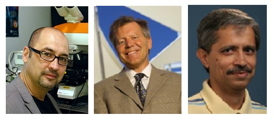Home > Press > Improving Heat Removal Qualities of Graphene: Three Bourns College of Engineering professors will share a $360,000 grant from the National Science Foundation
 |
| From left, Alexander A. Balandin, Roger Lake and Ashok Mulchandani |
Abstract:
Three Bourns College of Engineering professors at the University of California, Riverside have received a three-year, $360,000 grant from the National Science Foundation to further study the thermal properties of graphene, which is expected to lead to new approaches for the removal of heat from advanced electronic and optoelectronic devices.
Improving Heat Removal Qualities of Graphene: Three Bourns College of Engineering professors will share a $360,000 grant from the National Science Foundation
Riverside, CA | Posted on August 1st, 2013Alexander A. Balandin, a professor of electrical engineering and founding chair of the materials science and engineering program, Roger Lake, a professor of electrical engineering, Ashok Mulchandani, a professor of chemical engineering, will be cooperating on the project called: "Two-dimensional performance with three-dimensional capacity: Engineering the thermal properties of graphene."
Balandin will serve as principal investigator and be responsible for materials characterization and thermal measurements. Lake will perform theoretical and computational studies while Mulchandani will conduct material synthesis and characterization.
The unique properties of graphene - a single atomic plane of carbon atoms - were discovered in Balandin's Nano-Device Laboratory at UC Riverside in 2008. In recent years, the attention of the research community was focused on the properties of twisted bilayer graphene - a special form of graphene bilayers where atomic planes are rotated against each other by some angle.
The objective of this grant is to investigate the effect of rotation angle on the thermal conductivity of twisted bilayer graphene. The UCR team will study the possibility of suppressing the phonon coupling in twisted graphene layers, allowing for the transfer of extraordinary large heat fluxes. The phonons are quanta of crystal lattice vibrations that carry heat in graphene.
The possibility of maintaining two-dimensional properties of graphene in bulk materials through the use of twisting the stacking angles is a transformational concept giving us the best of both worlds - the enhanced performance of two-dimensional combined with the capacity of three-dimensional systems.
####
For more information, please click here
Contacts:
Sean Nealon
Tel: (951) 827-1287
Twitter: seannealon
Copyright © University of California, Riverside
If you have a comment, please Contact us.Issuers of news releases, not 7th Wave, Inc. or Nanotechnology Now, are solely responsible for the accuracy of the content.
| Related News Press |
News and information
![]() Researchers develop molecular qubits that communicate at telecom frequencies October 3rd, 2025
Researchers develop molecular qubits that communicate at telecom frequencies October 3rd, 2025
![]() Next-generation quantum communication October 3rd, 2025
Next-generation quantum communication October 3rd, 2025
![]() "Nanoreactor" cage uses visible light for catalytic and ultra-selective cross-cycloadditions October 3rd, 2025
"Nanoreactor" cage uses visible light for catalytic and ultra-selective cross-cycloadditions October 3rd, 2025
Graphene/ Graphite
![]() Electrifying results shed light on graphene foam as a potential material for lab grown cartilage June 6th, 2025
Electrifying results shed light on graphene foam as a potential material for lab grown cartilage June 6th, 2025
![]() Breakthrough in proton barrier films using pore-free graphene oxide: Kumamoto University researchers achieve new milestone in advanced coating technologies September 13th, 2024
Breakthrough in proton barrier films using pore-free graphene oxide: Kumamoto University researchers achieve new milestone in advanced coating technologies September 13th, 2024
Govt.-Legislation/Regulation/Funding/Policy
![]() New imaging approach transforms study of bacterial biofilms August 8th, 2025
New imaging approach transforms study of bacterial biofilms August 8th, 2025
![]() Electrifying results shed light on graphene foam as a potential material for lab grown cartilage June 6th, 2025
Electrifying results shed light on graphene foam as a potential material for lab grown cartilage June 6th, 2025
![]() Institute for Nanoscience hosts annual proposal planning meeting May 16th, 2025
Institute for Nanoscience hosts annual proposal planning meeting May 16th, 2025
Chip Technology
![]() Lab to industry: InSe wafer-scale breakthrough for future electronics August 8th, 2025
Lab to industry: InSe wafer-scale breakthrough for future electronics August 8th, 2025
![]() A 1960s idea inspires NBI researchers to study hitherto inaccessible quantum states June 6th, 2025
A 1960s idea inspires NBI researchers to study hitherto inaccessible quantum states June 6th, 2025
![]() Programmable electron-induced color router array May 14th, 2025
Programmable electron-induced color router array May 14th, 2025
Announcements
![]() Rice membrane extracts lithium from brines with greater speed, less waste October 3rd, 2025
Rice membrane extracts lithium from brines with greater speed, less waste October 3rd, 2025
![]() Researchers develop molecular qubits that communicate at telecom frequencies October 3rd, 2025
Researchers develop molecular qubits that communicate at telecom frequencies October 3rd, 2025
![]() Next-generation quantum communication October 3rd, 2025
Next-generation quantum communication October 3rd, 2025
![]() "Nanoreactor" cage uses visible light for catalytic and ultra-selective cross-cycloadditions October 3rd, 2025
"Nanoreactor" cage uses visible light for catalytic and ultra-selective cross-cycloadditions October 3rd, 2025
Photonics/Optics/Lasers
![]() ICFO researchers overcome long-standing bottleneck in single photon detection with twisted 2D materials August 8th, 2025
ICFO researchers overcome long-standing bottleneck in single photon detection with twisted 2D materials August 8th, 2025
![]() Institute for Nanoscience hosts annual proposal planning meeting May 16th, 2025
Institute for Nanoscience hosts annual proposal planning meeting May 16th, 2025
|
|
||
|
|
||
| The latest news from around the world, FREE | ||
|
|
||
|
|
||
| Premium Products | ||
|
|
||
|
Only the news you want to read!
Learn More |
||
|
|
||
|
Full-service, expert consulting
Learn More |
||
|
|
||








